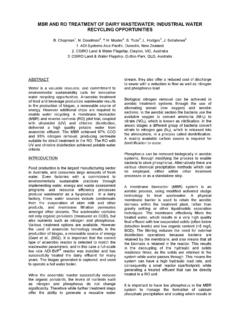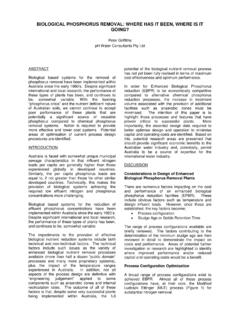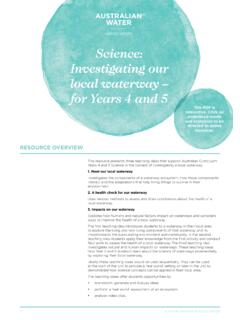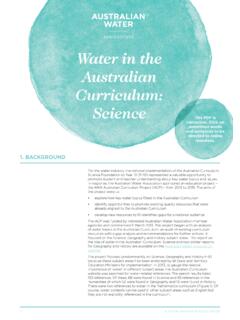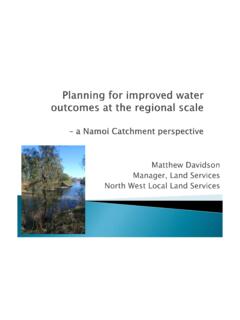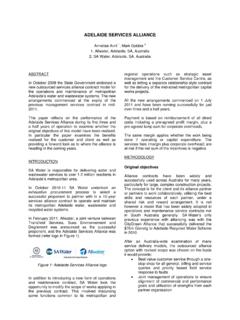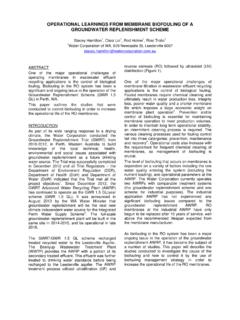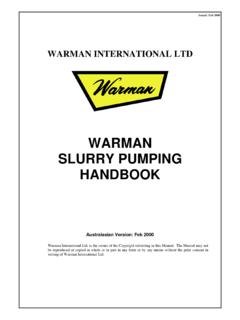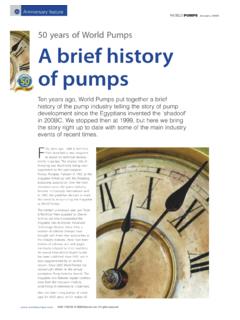Transcription of GOING THE DISTANCE: PRIMARY SLUDGE PUMPING
1 GOING THE distance : PRIMARY SLUDGE PUMPING . H Walmsley 1, 2, G Modulon 1, 2, W Schmiedte 1, 2, D Taylor 1, 2. 1. GHD Pty Ltd, Sydney, NSW, Australia 2. 4 Malabar Alliance, Sydney, NSW, Australia ABSTRACT Improve the operational conditions, by providing appropriate process capability, The composition of PRIMARY wastewater SLUDGE is reliability and operability of equipment. determined by a number of factors which vary significantly between treatment plants. Composition Malabar WWTP is a PRIMARY treatment plant, in turn affects SLUDGE rheological properties that consisting of six coarse and fine screens, four govern flow behaviour. In the design of pumped aerated grit tanks and six PRIMARY sedimentation SLUDGE transfer systems, rheology testing should be tanks. PRIMARY effluent is discharged via a deep carried out on relevant SLUDGE samples, if available, ocean outfall, km offshore at a depth of to increase the confidence in the input parameters approximately 80 m.
2 At Malabar, each PRIMARY used for friction loss calculations. sedimentation tank has a dedicated PRIMARY SLUDGE pump ( the pumps ) which transfers SLUDGE via a The accuracy of friction loss calculations to inform single rising main to one of three digesters for pump selection becomes more critical since a slight stabilisation. The capacity of the existing pumps to variation in calculated friction loss, and in turn satisfy operational requirements of the upgraded required pump head, will be amplified as the plant was reviewed as part of the PARR. transfer distance increases. During the design improvement project. phase for the project, the variance between friction loss calculations using a number of theoretical The six existing PRIMARY SLUDGE pumps are models led to in-situ pressure testing. Pressure test horizontal, end suction, belt-driven centrifugal open results were used to validate the Herschel-Bulkley impeller type slurry pumps (Warman model TC 4/4.)
3 Model as the most appropriate method for pipe units) with a relatively low PUMPING efficiency of 20. friction loss analysis for PRIMARY SLUDGE at Malabar to 30%. The nominal duty point of the units is 30 L/s Wastewater Treatment Plant. The Bingham plastic at 40 m head. PRIMARY SLUDGE is transferred via a model was also found to be comparable. 505 m long mild steel rising main (consisting of 170. m of DN150 and 335 m of DN250) to the furthest digester. Scum from the PRIMARY sedimentation INTRODUCTION. tanks is also collected and transferred into the PRIMARY SLUDGE rising main intermittently at 30 L/s. Malabar Wastewater Treatment Plant (Malabar The current system pumps SLUDGE between WWTP) is located in Sydney's eastern suburbs, and total solids residual (TSR) at around 15 km south east of the city. Commissioned approximately 20 - 25 L/s.
4 In the early 1970's, it is Sydney Water's largest wastewater plant with a peak wet weather flow of The behaviour of PRIMARY SLUDGE is affected by the 1,300 ML/d. total solids residual (TSR) of the SLUDGE . In turn, a change in TSR impacts on the operation of the Sydney Water is partnering with John Holland, SLUDGE pump. As the TSR increases, the system United Group Limited and GHD to form the pressure (for a given flow) also increases. The 4 Malabar Alliance, to deliver the Malabar Process existing centrifugal PRIMARY SLUDGE pumps see a and Reliability/Renewals (PARR) Improvement significant reduction in flow as the system pressure Project. The project aims to: increases, resulting in an insufficient volume of SLUDGE being transferred from the PRIMARY Improve the safety and working conditions at sedimentation tanks to the digesters.
5 This may lead the WWTP to an increased SLUDGE blanket depth within the Reduce operating costs by more efficiently PRIMARY sedimentation tanks, an increase in TSR. operating and controlling the WWTP, and and a further reduction in transfer capacity, creating reducing manual intervention an undesirable loop which continues until the point Ensure the plant complies with its is reached where the centrifugal pumps can no environmental protection licence longer deliver any flow to the digesters. Improve biosolids product quality The PARR improvement project requires the Flow Case 3: an emergency PUMPING reliable transfer of PRIMARY SLUDGE , with up to a configuration whereby the new SLUDGE higher TSR of 5% at 30 L/s, to a new SLUDGE screening facility is bypassed and the PRIMARY screening facility complete with a storage tank for SLUDGE is transferred at 30 L/s direct to the screened SLUDGE , prior to being transferred to the digesters.
6 Digesters via another new PUMPING facility. The existing PRIMARY SLUDGE rising main needs to be Transfer of SLUDGE up to at 30 L/s required extended to the new facility, resulting in a total friction loss calculations to be undertaken for the rising main length of 540 m. This change in above flow cases over a TSR range of to parameters results in an altered duty point for the to estimate the required pump operating duty. (The PRIMARY SLUDGE pumps, determined by the required case was estimated as an extreme event). flow, static head, minor system losses and pipeline friction losses. There was concern that the existing Rheological Properties centrifugal pumps would be unable to deliver the minimum requirement of 30 L/s at 5% TSR. A fluid may be characterised by the relationship Accurate friction loss calculations to inform pump between the shear stress and shear strain of the selection become more critical as the transfer fluid.
7 A Newtonian, or ideal fluid, has a linear distances increase, since the variation in pump duty relationship between stress and strain, meaning the resulting from an underestimate/overestimate of viscosity of the fluid is constant over all values of friction losses may result in the selected pump shear stress. Fluids not satisfying this criterion are operating outside its safe and efficient range. broadly referred to as Non-Newtonian fluids. A. Newtonian fluid (Figure 1) has the following shear To inform the friction loss calculations, rheological stress-shear strain relationship: testing of Malabar WWTP PRIMARY SLUDGE was completed to provide relevant data for analysis ( )= (1). using a range of theoretical models. The spread of calculated friction loss values was such that pressure testing of the existing PRIMARY SLUDGE PUMPING system was carried out to enable correlation of theoretical calculations.
8 This led to validation of the Herschel-Bulkley model and final pump head. PROCESS. This section outlines the process taken to determine the potential range of pump duty points for the upgraded PRIMARY SLUDGE PUMPING system. Figure 1: Newtonian Fluid This includes the establishment of design criteria and possible flow patterns, rheological testing to A fluid characterised by a Power Law relationship determine SLUDGE properties for input to theoretical no longer has a constant viscosity over all values of models and in-situ pressure testing to verify the shear strain. A Power Law fluid (Figure 2) has the calculated friction loss. following shear stress-shear strain relationship: Design Parameters ( )= (2). The main PUMPING configurations that will be used following the PARR upgrade are: Flow Case 1: 30 L/s SLUDGE transfer from the PRIMARY sedimentation tanks via a 540 m DN250 unlined steel duty SLUDGE rising main to the new PRIMARY SLUDGE screening facility, and then into the screened PRIMARY SLUDGE storage tank.
9 An additional 5 L/s of scum will be intermittently fed into the line at the existing scum tie-in point, 170 m downstream from the furthest PRIMARY SLUDGE pump. Flow Case 2: as per flow case 1, however via a 540 m DN200 glass lined standby SLUDGE rising main (repurposed disused pipework). Figure 2: Power Law A Bingham Plastic fluid behaves somewhat like a Understanding SLUDGE rheology is essential for Newtonian fluid; however the yield stress of the predicting flow behaviour in SLUDGE transfer fluid is the additional parameter which distinguishes systems. Using previously published rheological it from a Newtonian fluid. A Bingham Plastic fluid data to calculate system friction losses is will not flow until the shear stress applied exceeds considered undesirable for non-Newtonian PRIMARY the yield stress of the fluid.
10 This type of fluid may SLUDGE due to the significant variation in SLUDGE also be referred to as a visco-plastic or yield stress composition, and therefore rheological properties, fluid, some examples include mayonnaise and between plants. toothpaste. Once the fluid is moving, the shear stress increases proportionally to the shear rate. A At Malabar WWTP, even a slight variation in Bingham Plastic fluid (Figure 3) has the following calculated friction losses within the system is shear stress-shear strain relationship: amplified by the long distance the PRIMARY SLUDGE is transferred. Therefore, samples of SLUDGE were ( )= + (3) collected and rheological data derived from direct analysis of the plant's SLUDGE was obtained to improve the accuracy of friction loss calculations to inform pump selection for the calculated duty.
